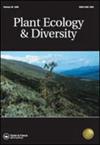Functional dominance is a better predictor than functional diversity of above-ground biomass in seasonally dry tropical forests
IF 1.6
4区 生物学
Q2 PLANT SCIENCES
引用次数: 0
Abstract
ABSTRACT Background The mass ratio hypothesis (functional dominance) and niche complementarity hypothesis (functional diversity) are two potential approaches for making the link between biodiversity and biomass. It is yet unclear how biodiversity and biomass are related in seasonally dry tropical forest (SDTF) communities where there is a seasonal water limitation. Aims The objective of this study was to quantify the effects of environmental filtering on ecosystem functioning, especially those related to biodiversity and above-ground biomass. Methods We estimated biomass and functional traits for all species in five plots at five sites in a SDTF. We related functional diversity and community-weighted trait mean (CWM) values to above-ground biomass (AGB) using linear mixed models. Results Functional diversity was not related to AGB, while CWM values of vessel density (VD) were positively and the Carlquist Vulnerability Index (CVI) was negatively related to AGB. Conclusion The CWM values of functional traits related to the trade-off between safety of water transport and the efficiency of water conductivity and conservative strategies (VD and CVI) were good predictors of AGB. The mass ratio hypothesis appears to be a better predictor of AGB than niche complementarity in our study conducted in the SDTF.在季节性干旱的热带森林中,功能优势比地上生物量的功能多样性更好地预测
质量比假说(功能优势假说)和生态位互补假说(功能多样性假说)是生物多样性与生物量之间联系的两种潜在方法。目前尚不清楚在季节性干旱热带森林(SDTF)群落中,生物多样性和生物量是如何相互关联的。目的研究环境过滤对生态系统功能的影响,特别是对生物多样性和地上生物量的影响。方法对SDTF 5个地点5个样地中所有物种的生物量和功能性状进行了估算。利用线性混合模型将功能多样性和群落加权性状平均值(CWM)与地上生物量(AGB)联系起来。结果功能多样性与AGB无关,血管密度(VD) CWM值与AGB呈正相关,而carquist脆弱性指数(CVI)与AGB呈负相关。结论水运安全与导水效率及保守策略(VD和CVI)之间权衡关系的功能性状CWM值是AGB的良好预测因子。在我们对SDTF进行的研究中,质量比假设似乎比生态位互补更能预测AGB。
本文章由计算机程序翻译,如有差异,请以英文原文为准。
求助全文
约1分钟内获得全文
求助全文
来源期刊

Plant Ecology & Diversity
PLANT SCIENCES-
CiteScore
3.30
自引率
0.00%
发文量
26
审稿时长
3 months
期刊介绍:
Plant Ecology and Diversity is an international journal for communicating results and novel ideas in plant science, in print and on-line, six times a year. All areas of plant biology relating to ecology, evolution and diversity are of interest, including those which explicitly deal with today''s highly topical themes, such as biodiversity, conservation and global change. We consider submissions that address fundamental questions which are pertinent to contemporary plant science. Articles concerning extreme environments world-wide are particularly welcome.
Plant Ecology and Diversity considers for publication original research articles, short communications, reviews, and scientific correspondence that explore thought-provoking ideas.
To aid redressing ‘publication bias’ the journal is unique in reporting, in the form of short communications, ‘negative results’ and ‘repeat experiments’ that test ecological theories experimentally, in theoretically flawless and methodologically sound papers. Research reviews and method papers, are also encouraged.
Plant Ecology & Diversity publishes high-quality and topical research that demonstrates solid scholarship. As such, the journal does not publish purely descriptive papers. Submissions are required to focus on research topics that are broad in their scope and thus provide new insights and contribute to theory. The original research should address clear hypotheses that test theory or questions and offer new insights on topics of interest to an international readership.
 求助内容:
求助内容: 应助结果提醒方式:
应助结果提醒方式:


